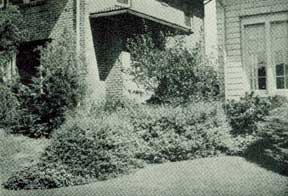Variety Among the Evergreens
By VICTOR H. RIES
Nature Magazine, September 1937
Evergreen plantings need not be so somber if you combine some of the broad-leaved evergreens with the conifers. The variety of foliage effect, the difference in habit of growth thus obtained, not only relieves the monotony but gives a de-lightful and artistic effect. Although any of a number of different broad-leaf evergreens may be used, an outstanding one is the firethorn, Pyracantha. Closely related to the hawthorn, it might even be called an evergreen hawthorn, for its sharp spines and orange-red berries somewhat resemble the thorn-apples.
Like the hawthorns, they are best planted in the spring. Since they are a little difficult to transplant, they should be handled in the small size, preferably not over 2 feet high, with solid balls of earth held in place by burlap. Some nurserymen prefer to sell them as pot plants in four, six or eight-inch clay pots. As the shrubs are relatively quick growing, these potted ones are quite satisfactory.

VARIETY, THE SPICE OF GARDEN DECORATION
The firethorn grows in sun or partial shade and in either alkaline or acid soil. They are of vigorous growth but, if space is restricted, they can be kept within bounds by early spring pruning or by root pruning. This is accomplished by cutting the roots with a tilling spade even with the tips of the branches every spring or two, depending on the vigor.
Since hardiness is desirable, it is advisable to buy your plants from a nursery in your own latitude. Although they stand temperatures as low as ten to twenty below, it is best not to plant them in places exposed to cold winds.
It is difficult to recommend definite varieties since the firethorns are badly mixed. Nine times out of ten you will get Pyracantha coccinea lalandi, which is satisfactory. Pyracantha crenulata rogersiana and P. gibbsii are claimed by some to be hardier and of better habit. For fruiting it is best to plant in groups of two or more.
 Printer-friendly version
Printer-friendly version
